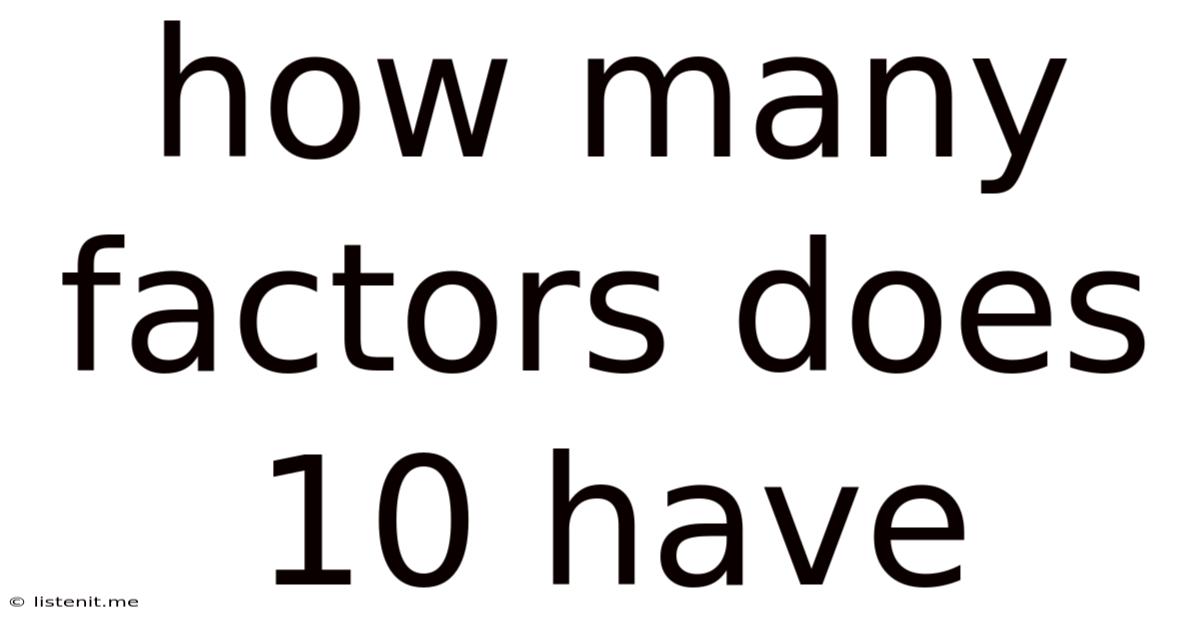How Many Factors Does 10 Have
listenit
May 25, 2025 · 5 min read

Table of Contents
How Many Factors Does 10 Have? A Deep Dive into Factorization
The seemingly simple question, "How many factors does 10 have?" opens a door to a fascinating exploration of number theory, prime factorization, and the fundamental building blocks of mathematics. While the answer itself is straightforward, understanding the underlying concepts provides a solid foundation for tackling more complex mathematical problems. This article will not only answer the question but also delve into the methods for finding factors, explore related concepts, and illustrate the practical applications of factorization.
Understanding Factors
Before we tackle the specific case of 10, let's define what a factor is. A factor, or divisor, of a number is a whole number that divides the number exactly without leaving a remainder. In simpler terms, it's a number that you can multiply by another whole number to get the original number. For example, the factors of 6 are 1, 2, 3, and 6 because:
- 1 x 6 = 6
- 2 x 3 = 6
Finding the Factors of 10
Now, let's find the factors of 10. We need to identify all the whole numbers that divide 10 without leaving a remainder. These are:
- 1: 1 x 10 = 10
- 2: 2 x 5 = 10
- 5: 5 x 2 = 10
- 10: 10 x 1 = 10
Therefore, the factors of 10 are 1, 2, 5, and 10. This means 10 has four factors.
Prime Factorization: A Powerful Tool
The process of finding factors becomes significantly easier when we utilize prime factorization. Prime factorization is the process of expressing a number as a product of its prime factors. A prime number is a whole number greater than 1 that has only two factors: 1 and itself (e.g., 2, 3, 5, 7, 11...).
Let's find the prime factorization of 10:
10 can be written as 2 x 5. Both 2 and 5 are prime numbers. Therefore, the prime factorization of 10 is 2<sup>1</sup> x 5<sup>1</sup>.
Understanding the prime factorization is crucial because it provides a systematic way to determine all the factors of a number. Once we have the prime factorization, we can derive all possible combinations of the prime factors and their powers to find all the factors.
Deriving All Factors from Prime Factorization
From the prime factorization 2<sup>1</sup> x 5<sup>1</sup>, we can deduce all the factors of 10:
- Using only the prime factor 2: 2<sup>0</sup> (which is 1) and 2<sup>1</sup> (which is 2)
- Using only the prime factor 5: 5<sup>0</sup> (which is 1) and 5<sup>1</sup> (which is 5)
- Using both prime factors: 2<sup>1</sup> x 5<sup>1</sup> (which is 10)
- 2<sup>0</sup> x 5<sup>0</sup> = 1
This method systematically reveals all four factors: 1, 2, 5, and 10.
Number of Factors: A Formula
There's a formula to calculate the number of factors of a given number directly from its prime factorization. If the prime factorization of a number n is given by:
n = p<sub>1</sub><sup>a<sub>1</sub></sup> x p<sub>2</sub><sup>a<sub>2</sub></sup> x ... x p<sub>k</sub><sup>a<sub>k</sub></sup>
where p<sub>i</sub> are distinct prime factors and a<sub>i</sub> are their respective exponents, then the number of factors is given by:
(a<sub>1</sub> + 1)(a<sub>2</sub> + 1)...(a<sub>k</sub> + 1)
Applying this to 10 (2<sup>1</sup> x 5<sup>1</sup>), we have:
(1 + 1)(1 + 1) = 2 x 2 = 4
This confirms our earlier finding that 10 has four factors.
Extending the Concept: Factors of Larger Numbers
Let's apply these concepts to a larger number, say 72.
-
Prime Factorization: 72 = 2<sup>3</sup> x 3<sup>2</sup>
-
Number of Factors: (3 + 1)(2 + 1) = 4 x 3 = 12
Therefore, 72 has 12 factors. We can list them systematically using combinations of 2 and 3:
1, 2, 3, 4, 6, 8, 9, 12, 18, 24, 36, 72
Practical Applications of Factorization
Factorization, seemingly a simple concept, has far-reaching applications in various fields:
-
Cryptography: Many encryption methods rely heavily on the difficulty of factoring large numbers into their prime factors. The security of these systems depends on the computational infeasibility of factoring very large numbers.
-
Algebra: Factorization is a crucial tool for simplifying algebraic expressions and solving equations. It allows us to express polynomials in a more manageable form.
-
Computer Science: Algorithms involving factorization are used in various computer science applications, including data compression and optimization.
-
Music Theory: Mathematical concepts related to factorization find applications in music theory, particularly in understanding harmonies and chord progressions.
-
Engineering: Factorization plays a role in solving engineering problems involving ratios and proportions.
Conclusion: Beyond the Simple Answer
While the answer to the question "How many factors does 10 have?" is simply 4, the path to finding that answer reveals a wealth of mathematical concepts and practical applications. Understanding prime factorization and the formula for calculating the number of factors allows us to efficiently determine the factors of any number, regardless of its size. This seemingly basic problem provides a gateway to a deeper appreciation of the elegance and power of number theory. By exploring this seemingly simple problem, we've unlocked a window into a world of mathematical depth and practical significance. The understanding of factors extends far beyond simple arithmetic, touching upon the core principles that underpin numerous fields of study and technological advancements.
Latest Posts
Latest Posts
-
Ac Tonnage Calculator Per Square Meter
May 25, 2025
-
7 Years Ago Was What Year
May 25, 2025
-
1 4 Divided By 4 In Fraction
May 25, 2025
-
What Is 72 As A Fraction
May 25, 2025
-
Highest Common Factor Of 84 And 24
May 25, 2025
Related Post
Thank you for visiting our website which covers about How Many Factors Does 10 Have . We hope the information provided has been useful to you. Feel free to contact us if you have any questions or need further assistance. See you next time and don't miss to bookmark.